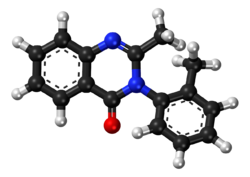Methaqualone
 |
|
 |
|
| Clinical data | |
|---|---|
| Pronunciation | meth-ə-KWAY-lon |
| Pregnancy category |
|
| ATC code | N05CM01 (WHO) |
| Legal status | |
| Legal status |
|
| Identifiers | |
|
|
| CAS Number |
72-44-6 |
| PubChem (CID) | 6292 |
| DrugBank |
DB04833 |
| ChemSpider |
6055 |
| UNII |
7ZKH8MQW6T |
| KEGG |
D00557 |
| ChEMBL |
CHEMBL282052 |
| ECHA InfoCard | 100.000.710 |
| Chemical and physical data | |
| Formula | C16H14N2O |
| Molar mass | 250.30 g/mol |
| 3D model (Jmol) | Interactive image |
| Melting point | 113 °C (235 °F) |
|
|
|
|
Methaqualone, sold under the brand name Quaalude (KWAY-lood, \ˈkwā-ˌlüd\) in the US and Mandrax in the UK and South Africa, is a sedative and hypnotic medication. It is a member of the quinazolinone class.
The sedative–hypnotic activity of methaqualone was first noted by researchers in the 1950s. In 1962, methaqualone was patented in the US by Wallace and Tiernan. Its use peaked in the early 1970s as a hypnotic, for the treatment of insomnia, and as a sedative and muscle relaxant.
Methaqualone is a depressant that increases the activity of the GABA receptors in the brain and nervous system. When GABA activity is increased, blood pressure drops and the breathing and pulse rates slow, leading to a state of deep relaxation. These properties explain why methaqualone was originally mainly prescribed for insomnia.
Methaqualone peaks in the bloodstream within several hours, with a half-life of 20–60 hours. Regular users build up a physical tolerance, requiring larger doses for the same effect. Overdose can lead to nervous system shutdown, coma and death.
Methaqualone is not recommended for use while pregnant and is in pregnancy category D. In Canada, methaqualone is listed in Schedule III of the Controlled Drugs and Substances Act and requires a prescription. Methaqualone is banned in India.
Methaqualone became increasingly popular as a recreational drug in the late 1960s and 1970s, known variously as ludes or sopers (also soaps) in the U.S. and mandrakes and mandies in the UK, Australia and New Zealand.
The drug was often used by hippies and by people who went dancing at glam rock clubs in the 1970s and at discos. (One slang term for Quaalude was disco biscuits.) In the mid-1970s, there were bars in Manhattan called juice bars that only served non-alcoholic drinks that catered to people who liked to dance on methaqualone.
...
Wikipedia
